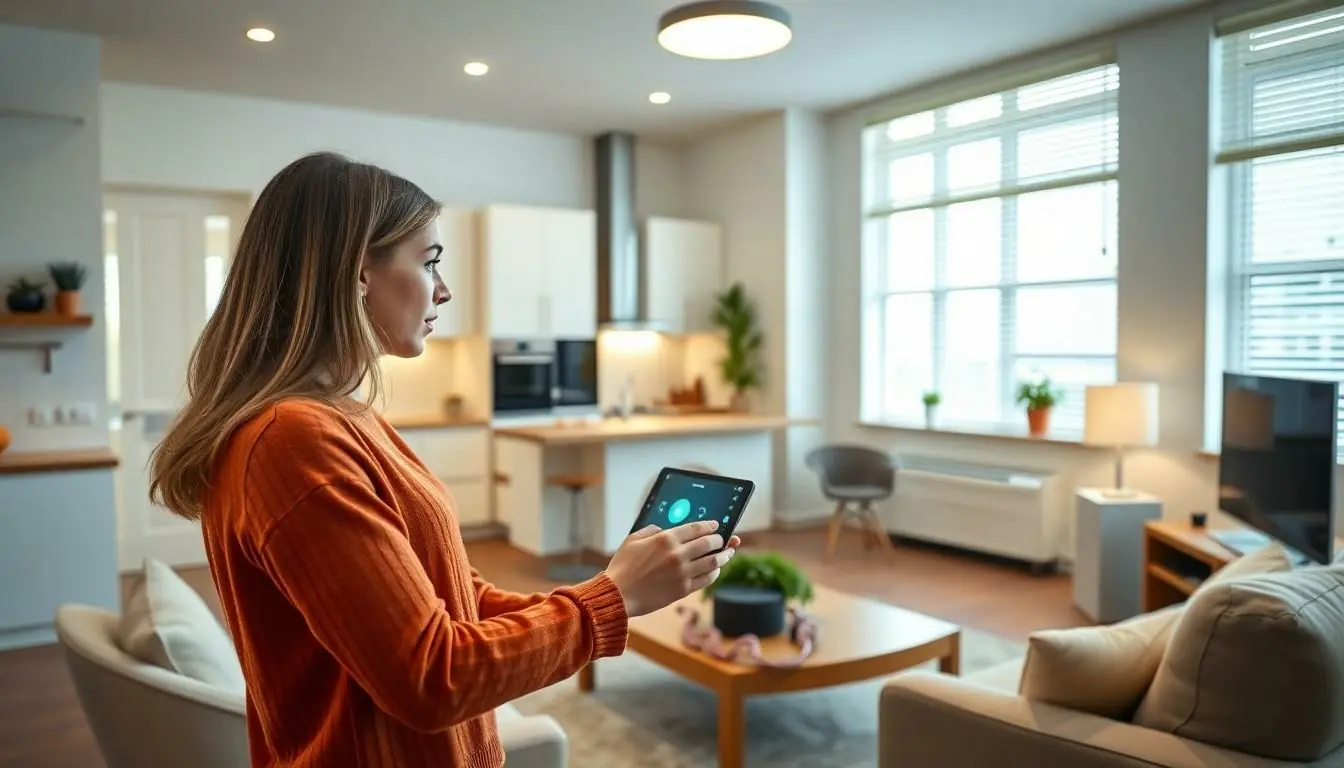Imagine walking into your home and having it greet you like an old friend. Smart home construction isn’t just a trend; it’s a revolution in how we live. With the right technology, homes can now think for themselves, making life easier, safer, and—let’s face it—way cooler.
Table of Contents
ToggleOverview of Smart Home Construction
Smart home construction incorporates technology into building design and operations. Automation systems enhance energy efficiency, security, and comfort. Innovative features allow homeowners to control lighting, climate, and appliances easily. Sensors installed throughout the property monitor energy usage and security status in real-time.
The integration of smart devices simplifies daily tasks. Voice-activated assistants enable users to manage home environments through spoken commands. In addition, connected devices can communicate with each other, creating a cohesive network that operates seamlessly.
Data collected from smart home systems contributes to personalized experiences. By analyzing user preferences, technology can adjust settings automatically. For example, climate control adjusts temperatures based on occupancy patterns, promoting energy savings and comfort.
Materials and design elements in smart homes prioritize sustainability. Renewable energy sources, such as solar panels, often power these homes, reducing overall reliance on traditional energy grids. Moreover, energy-efficient building materials reduce environmental impact.
Emerging technologies frequently reshape smart home construction. Smart locks, security cameras, and home monitoring devices enhance safety and peace of mind. The trend toward environmentally friendly and technologically advanced homes reflects growing consumer demands.
Investments in smart home infrastructure show significant growth. Market analysts predict the smart home market will reach $174 billion by 2025. As demand increases, construction practices will continue to evolve, embracing the latest advancements in technology.
Smart home construction represents a significant evolution in residential design. It offers homeowners new levels of convenience, efficiency, and security. With ongoing advancements, the future of living spaces becomes increasingly integrated with technology.
Key Components of Smart Homes

Smart homes integrate various advanced technologies, enhancing convenience and security. Key components include home automation systems, security features, and energy management solutions.
Home Automation Systems
Home automation systems enable seamless control of household devices. Smart lighting adjusts brightness based on time and occupancy. Climate control systems optimize heating and cooling, contributing to comfort and efficiency. Voice assistants facilitate easy management of appliances, making daily tasks simpler. Users can schedule operations, enhancing convenience and reducing energy consumption. Popular platforms like Amazon Alexa, Google Assistant, and Apple HomeKit connect devices for real-time responses.
Security Features
Security features in smart homes provide enhanced protection. Smart locks allow remote access control, enabling users to manage entry points securely. Security cameras with motion detection monitor surroundings in real time, offering peace of mind. Alarm systems notify homeowners and local authorities of suspicious activities, enhancing safety measures. Integration with smart home systems allows for remote monitoring from mobile devices. Data from these devices helps owners stay aware of their home environment, promoting a secure living experience.
Energy Management Solutions
Energy management solutions play a crucial role in supporting sustainability. Smart thermostats learn user preferences, adjusting settings to maximize energy efficiency. Automated window blinds help regulate indoor temperatures, reducing heating and cooling costs. Solar panels paired with battery storage optimize energy usage and lower utility bills. Real-time monitoring of energy consumption empowers homeowners to make informed decisions about usage patterns. These solutions significantly decrease a home’s environmental impact.
Benefits of Smart Home Construction
Smart home construction offers numerous advantages that significantly improve living standards.
Convenience and Comfort
Smart home technology enhances daily routines through automation. Homeowners enjoy seamless control of lighting, climate, and appliances via smartphones or voice-assisted devices. Smart devices adapt to personal preferences and occupancy, ensuring optimal comfort at all times. Users often schedule automated tasks, such as adjusting temperatures or dimming lights, to suit their lifestyles. Connected appliances contribute to time savings, allowing individuals to manage household tasks efficiently. By linking devices together, they create a responsive living environment that transforms the way residents experience their homes.
Energy Efficiency
Smart home features prioritize energy efficiency, benefiting both homeowners and the environment. Automation systems regulate heating, cooling, and lighting based on real-time data, significantly reducing energy consumption. Smart thermostats learn user behaviors to optimize energy settings, leading to cost savings on utility bills. Advanced sensors monitor energy usage, enabling occupants to identify patterns and adjust habits accordingly. Integrating renewable energy solutions, such as solar panels, further enhances sustainability efforts. As a result, smart homes contribute to a lower carbon footprint and promote environmentally responsible living.
Enhanced Security
Home security reaches new heights with smart home construction. Advanced systems include smart locks, motion detectors, and security cameras that allow remote monitoring and control. Homeowners receive instant alerts about suspicious activities, increasing their peace of mind. Integrating these features provides flexibility in managing home safety, enabling users to monitor properties from anywhere. Automated security protocols respond to breaches, adding another layer of protection. Enhanced security measures address consumer concerns about safety, making smart homes an attractive option for many.
Challenges and Considerations
Smart home construction brings several challenges. Addressing these challenges is vital for successful implementation.
Cost and Budgeting
Initial investment in smart home technology often exceeds traditional construction costs. It’s important to account for expenses related to smart devices, installation, and ongoing maintenance. A well-planned budget can help homeowners make informed decisions. Prioritizing essential features, such as smart security and energy management systems, can optimize spending. Long-term savings from energy efficiency may offset upfront costs, making smart home systems an attractive investment.
Technology Integration
Integrating diverse smart technologies into a cohesive system presents challenges. Compatibility issues arise when mixing products from different manufacturers. Coordination between devices requires reliable networking infrastructure. Homeowners should choose platforms with wide compatibility to streamline integration. Proper planning and collaboration with skilled professionals ensure effective implementation of technology solutions. Prioritizing user-friendly systems enhances the overall experience and contributes to system longevity.
Privacy and Security Concerns
Smart homes increase data collection, raising privacy concerns among homeowners. Vulnerabilities in connected devices can lead to unauthorized access to personal information. Prioritizing strong security measures, such as encryption and regular updates, mitigates risks. Homeowners must also be aware of privacy policies related to their devices. Educating oneself about potential threats empowers homeowners to safeguard their digital environments effectively. Integrating robust security practices creates a safer living experience.
Future Trends in Smart Home Construction
Smart home construction continues to evolve, driven by innovative technologies and consumer demand. The integration of artificial intelligence significantly enhances user experience, providing proactive solutions tailored to individual preferences. Increased adoption of Internet of Things devices allows for seamless connectivity across various platforms, creating enhanced automation opportunities.
Homeowners prioritize energy efficiency as more materials and systems become available. Solar technology gains prominence, with installations on rooftops providing sustainable energy solutions. Smart grids facilitate energy management, allowing homes to adjust energy consumption based on real-time demand and pricing.
Smart safety features expand beyond traditional locks and cameras. Biometric systems offer advanced security options, ensuring only authorized individuals gain access to properties. Furthermore, advanced sensors can detect unusual activities, alerting homeowners immediately.
The role of virtual and augmented reality in designing smart homes grows. Home builders and architects utilize these technologies to provide virtual walkthroughs of spaces, enabling clients to visualize their projects before construction begins. This advancement allows better customization and informed decision-making.
Incorporating voice-activated technology continues to gain traction. Smart speakers and displays serve as central control hubs, enabling comprehensive interaction with all connected devices. Homeowners find these systems intuitive and user-friendly.
Sustainability emerges as a key consideration in home design. Innovations in eco-friendly materials and waste reduction practices shape construction methods. Manufacturers develop products that align with these values, appealing to environmentally conscious buyers.
Smart home construction trends prioritize integration, efficiency, and safety. Consumer preferences strongly influence these advancements, ensuring smart homes remain at the forefront of residential living. Market predictions place the smart home sector’s value at $174 billion by 2025, highlighting its rapid growth.
Smart home construction is transforming how people live and interact with their environments. By embracing advanced technology homeowners can enjoy enhanced convenience efficiency and security. The integration of smart devices not only simplifies daily tasks but also promotes sustainability through energy-efficient practices.
As the market continues to grow and evolve innovations like artificial intelligence and IoT devices will further redefine residential living. Homeowners are encouraged to navigate challenges thoughtfully ensuring that their investments yield long-term benefits. Ultimately smart home construction represents a future where technology and comfort coexist seamlessly enriching lifestyles and creating safer more efficient living spaces.






